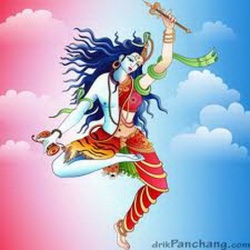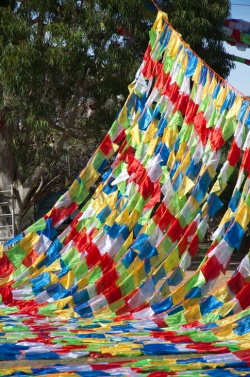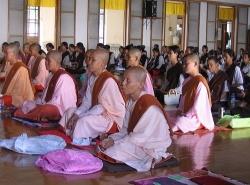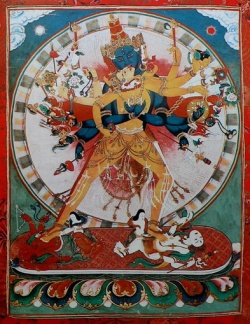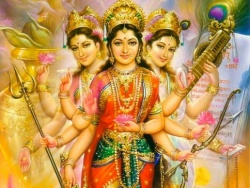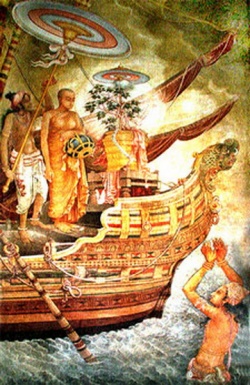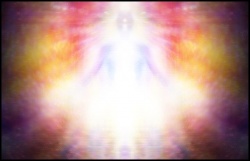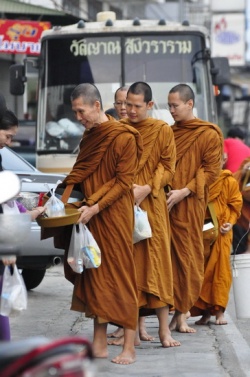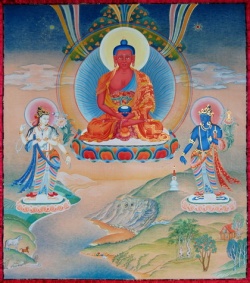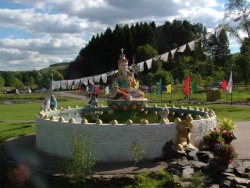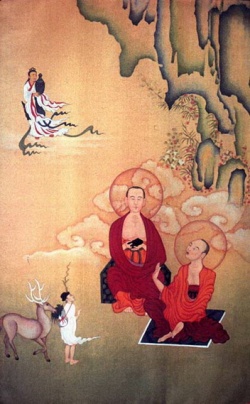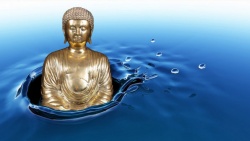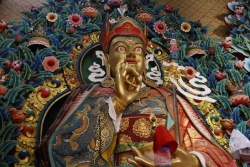Gate Mantra and the Three Stages of Ch’an Practice
By Maha Acarya Yang Fo Xing
In life as well as in Buddhism practice, one has to have a clear path in order to achieve one’s goals readily. Many practitioners of Buddhism recite the Gate Mantra of the Heart Sutra (Prajna-Paramita-Hrdaya Sutra). But what is its esoteric meaning, its relationship with the three stages of Ch’an practice and how to understand better some important issues of both the Ch’an School and Esoteric School? These are questions that dedicated Buddhism practitioners wish to clarify and understand. The followings are my view in these issues.
Part I
The Relationship Between Comprehension
Of Buddhist Teachings and Actual Practice
Gate Mantra of the Prajna-Paramita-Hrdaya Sutra is an esoteric mantra and corresponds to the essence of the Ch’an school Prajna-Paramita. Both the Ch’an school and the Esoteric schools are Oneyana. (One Vehicle or Buddha Vehicle) “As for practitioners of Oneyana Sudden School, their comprehension of Buddhist doctrines comes from their actual practice. They focus their spiritual cultivation on actual practice with their comprehension of Buddhist doctrines complementing it. With progress in actual practice, comprehension of the teachings will deepen accordingly. The higher stage they attain in actual practice, the better their comprehension will be. Practice without comprehension of Buddhist doctrines is a Worldly Religion while comprehension of such teachings without actual practice is mere philosophy.”1
When practitioners’ comprehension of Buddhist teachings corresponds to their actual practice, they reach the state of Samadhi and accord with the truth of Dharmadhatu; and their comprehension of Buddhism will conform naturally to the Buddhist teachings and is different from the understanding of these doctrines through pondering on their literal meanings. This explains why the Sixth Patriarch of the Ch’an school could expound Buddhist scriptures despite the fact that he was illiterate. His responses to people’s questions were quick, concise and appropriate. He said: “The profundity of the teachings of various Buddhas’ has nothing to do with the written language. When one knows his own heart , he will realize his own Essence of Mind.”2 “Buddha is sought from within, how can it be found externally?”3 Maha Acarya Feng Da An once instructed: “If one practices Cundi Ritual and reaches the highest attainment, he can enter Dharma Flower Samadhi and then the Wonderful Dharma Lotus Flower Sutra will become his words.”
Part II
The Theory of Permeation
One Chinese idiom goes: “He who stays near vermilion gets stained red, and he who stays near ink gets stained black.” It means one blends with the color of one’s company. As no one can exist by himself in this world, he is definitely under various kinds of influences. For example, if an ordinary student makes friend with a student with honor, he progresses and if he associates himself with bad students, he will easily become one of them. Asvaghosa Bodhisattva said: “When Suchness (Bhutatathata) penetrates ignorance, sentient beings can eliminate their karmic obstruction and reach enlightenment. As their previous delusions disappear and the true nature surfaces, they reach a state of complete tranquility and brightness; Their minds become purer and quicker.”4 On the other hand, “When ignorance defiles Suchness, their true nature will be veiled by delusion, their negative karmic actions will accumulate and be bound by the cycle of life and death with endless mental afflictions.”5 In general, the true nature of sentient beings is always defiled by ignorance, thus their karmic obstructions become bigger and bigger and their mind become more and more confused.
If a practitioner of Oneyana gets the blessings of an enlightened master and practices with the Four Kinds of Heart - Pure Heart, Heart with Utmost Sincerity, Heart of Diligent Practice, and Heart of Repaying Four Kinds of Kindness, his ignorance will be purified by Suchness. When his Alaya Vijnana becomes pure, his mind will be clearer and quicker.
Part III
The Relationship Between Natural Capacity of Sentient Beings,
Giving Teachings Suitable to Their Capacities and Choice of Masters
There are 84,000 Dharma-doors in Buddhism to suit the various natural capacities of sentient beings. The medicine which cures patients is good medicine regardless of its value. Likewise, all Dharma-doors are sublime as long as they can benefit sentient beings. When people are unenlightened, they tend to argue about advantages of this or that Dharma-door. But once they are enlightened, they will realize all Dharma-doors are interconnected with one another. Practitioners with high natural capacity can correspond easily to the sudden teaching of Oneyana which has very strict requirements for its patriarchs. Only enlightened people who penetrate the essence of Buddhist teachings are qualified to be patriarchs and this explains the reason for Master Hong Ren’s choice of Dharma successor. As the Fifth Patriarch of the Ch’an School, he would rather pass his Dharma and robe to Hui Neng who was illiterate than to the knowledgeable instructor Shen Xiu. The Fifth Patriarch was wise and had the ability to judge his disciple’s natural capacity. Many people have the wrong understanding that the Fifth Patriarch passed on the lineage to Hui Neng because the latter’s stanza (“Fundamentally Bodhi is no tree. Nor the clean mirror a stand. Everything is primordially empty. What is there for dust to cling to?”) 6 was better than that of Shen Xiu (“Our body is the Bodhi tree. And our heart a mirror stand. Cleaning the mirror regularly. So that no dust can cling to”)7 . However, this is not the true picture. After Hui Neng composed the stanza, the Fifth Patriarch preached Dharma to Hui Neng, blessing him while expounding to him the Diamond Sutra. When he came to the verse: “They (Buddhas and Bodhisattvas) should develop a mind that doesn’t abide in anything.”8 Hui Neng became greatly enlightened and said the five “who would have thought”: “Who would have thought that the Essence of Mind is intrinsically self-sufficient… Who would have thought that all things are the manifestations of the Essence of Mind.” It was then that the Fifth Patriarch realized that Hui Neng had become completely enlightened and perceived the essence of the Dharma. Therefore, he transmitted to him the lineage of the Ch’an school. An enlightened one can obtain the Buddhas’ Energy Current of the ten directions and penetrate the mind of sentient beings. He can also transfer Buddhas’ Energy Current to practitioners. Only if a person possesses such abilities can he transmit the Mind Seal of the Buddha and spread Buddhism to future generations. The one who attains the Essence of Dharma will realize the truth that “The profundity of teachings of various Buddhas have nothing to do with written language. When one knows his own heart, he will realize his Essence of Mind.” Since Shen Xiu had not reached this state, he was not chosen as Dharma successor. The patriarchs of the T’ang Dynasty Esoteric School (Tang Mi in Chinese) are even more strict in choosing their successors. For example, the Fourth Patriarch of the T’ang Dynasty Esoteric School Nagabodhi lived in the world for nearly a thousand years for the goodness of the people. The three Mahasattvas of the Kai Yuan (A.D.713-741) Period of the T’ang Dynasty (A.D.618-907) - Subhakarasimha, Vajrabodhi and Amoghavajra received his teachings when he was nearly 800. Subhakarasimha and Vajrabodhi were both the Fifth Patriarch and Amoghavajra - the Sixth Patriarch was their mutual successor. Later, Amoghavajra went back to India and personally received teachings and initiation from Nagabodhi Bodhisattva.
The Origin of Buddhism written by Maha Acarya Feng Da An quotes: “The practice of Buddhism will have true effect when there lives an enlightened Transferer of Buddhas’ Energy Current who is able to obtain the Buddhas’ Energy Current of the ten directions and confer them on sentient beings. It goes without saying that when Shakyamuni Buddha lived in the world, he was such a Transferer. After Buddha passed into Nirvana and if there are no enlightened people to function as such Transferers of Buddhas’ Energy Current, practitioners could hardly correspond to Buddhas’ Energy Current. Their understandings of Buddhist doctrines are superficial. They have no hope of attaining fruition…”9
From this instruction, practitioners of Oneyana should realize the importance of choosing a qualified master.
Part IV
The Stages of Practicing Samadhi
It’s of great importance for a practitioner of Oneyana to grasp its guiding principles. Only when his mind is deep in Samadhi can he begin to correspond to the wonderful teachings of the school and gain great benefits. Maha Acarya Feng Da An summarized the process and rules for practitioners to follow to attain Samadhi:
1. All sentient beings, regardless of their status, have many deep-rooted habits hard to eliminate. (The author’s comment: It’s important for one to be aware of his shortcomings. A practitioner should face his bad old habits, rectify and even get rid of them in order to break through ignorance and find luminosity from the heart.)
2. If one concentrates on practicing one kind of Samadhi, he should rely on the Buddhas’ Energy Currents to gradually develop the pure Seed Nature of this Samadhi. (The author’s comment: For example, when one practices the Cundi Ritual, he has to depend on the Seven Kotis (seventy million) of Buddhas’ Energy Current.)
3.The pure Seed Nature cultivated by practitioners is always in constant conflict or struggle with the defiled deep-rooted habits that he has accumulated over a long time. (The author’s comment: This is the Permeation Theory of Asvaghosa Bodhisattva. For example, if a practitioner of Cundi Ritual recites the Cundi Mantra one time, the pure Seed Nature and Energy Current of Cundi Bodhisattva will purify the defiled old habits deep rooted in his Alaya Vijnana for one time. This is what is called as “permeation of Suchness into ignorance.” On the other hand, when one is indulged in seeking for worldly pleasures with a deluded mind, Suchness can be defiled by ignorance. The above-mentioned two forces oppose and struggle with each other constantly. When the force of the former outweighs that of the latter, the practitioner makes progress in his spiritual cultivation, eliminates negative karmic obstruction and becomes enlightened. He would reach a state of complete tranquility and brightness and his mind turns purer and quicker. Otherwise, he can only retrogress in his cultivation, go after delusions, and create negative karmic actions which will bind him to the cycle of life and death. As a result, he will suffer from all kinds of mental afflictions.)
4. The force of Seed Nature one cultivates gradually grows strong. When it is strong enough for the practitioner to get rid of the deep-rooted habits, he is hopeful to reach the state of Samadhi. (The author’s comment: If he can break off Discriminating Attachment to Ego and Discriminating Attachment to Things as Realities, he attains to the state of Gen Shen. If he breaks off Innate Attachment to Ego, he reaches the state of Suchness as Intrinsic Void. When he breaks off Innate Attachment to Things as Realities, he realizes the state of Absolute Void. Attachment is closely related to one’s deep-rooted habits.)
5. When he has approached the state of Samadhi, he could understand what he couldn’t understand before and the sublime state he couldn’t reach suddenly reveals itself. This state continues until he reaches the pure and permanent state of Dharmakaya. (The author’s comment: When a practitioner nearly gets to the state of Samadhi, his ignorance and karmic obstructions become smaller. The innate great wisdom breaks through obstructions and Suchness rapidly reveals itself.)
Part V
The Relationship and Differences
Between the Ch’an school and the Esoteric School
Both the Ch’an School and the Esoteric School are Oneyana. The fundamental principle of the two schools is the same in the initial stage of practice when practitioners’ Alaya Vijnana functions after eliminating the first Six Kinds of Consciousness. Yet, the two schools differ in the process of practice. When people are unenlightened, they tend to argue about the advantages of this or that Dharma-door. But once they are enlightened, they would realize that all Dharma - doors are interconnected with one another. Ch’an practitioners consider the realization of Prajna Paramita as the highest stage in their practice. Once they reach this stage, they start to deliver sentient beings. It is through this action of crossing over sentient beings that they reach Buddhahood. However, in Esoteric School only when esoteric practitioners reach the state of Prajna Paramita can they be regarded as Real Esoteric Practitioners. (Zheng Ji in Chinese) Their practice to attain Buddhahood has just begun. They start to deliver sentient beings after they reach Buddhahood. Esoteric practitioners can make progress by relying on the Ch’an School while Ch’an practitioners can quickly become accomplished by relying on the Esoteric School. (Refer to article written by Maha Acarya Feng Da An Realization of Self-nature of the Ch’an School and Attaining Buddhahood in This Life of the Esoteric School)
Part VI
Miraculous Uses of Mantras
Mantras flow from Buddhas’ hearts. Whether they are monosyllabic or multi-syllabic, they possess boundless virtues of Buddhas. Only when a practitioner applies the All-discerning Wisdom can he distinguish them. Although mantras become worldly sounds through the mouths of practitioners, they have great functions as they rely on the power of blessing. This is the reason for the inconceivable effects a practitioner can achieve if he receives the orthodox Three Mysteries from a qualified master and recites mantras piously. All electric appliances have to be connected with electric current to work properly or they are like waste products. Likewise, no matter with what Dharma-door a practitioner starts his practice, he must correspond to the Buddhas’ Energy Currents to reach a higher stage easily. Otherwise, he can only expect to accomplish his goal in the far future. He should bear the following theory in mind. When electric pressure is stabilized, electric current is inversely proportional to electric resistance. When resistance is strong, current is weak. When resistance is strong enough to certain extent, current cannot pass and the electric appliances cannot work. He should also attach importance to the following teaching in the same manner. “When scattered thinking exists, Suchness is covered.”10 Scattered thinking is compared to resistance, which blocks the power of Buddhas’ Energy Currents. So it prevents the practitioner from having real effects of practice. However, if he regards Four Kinds of Hearts as guidelines for his thinking and action in everyday life and recites mantras piously and single-mindedly in performing rituals, his utmost sincerity and diligent practice can bring him great results. As the proverb goes: “One’s utmost sincerity can penetrate even the gold rock”, he will feel the great power of blessing from Buddhas and attains to the stage “When scattered thinking vanishes, Suchness reveals itself.”11Only then can he internally prove the fact that the five aggregates (Sklandhas) are void.
Part VII
Gate Mantra and the Three Stages of Ch’an Practice
Gate, Gate: If a practitioner breaks off the Discriminating Attachment to Ego and Discriminating Attachment things as Realities, he reaches the first stage of Ch’an practice. (Chu Guan in Chinese)
Why does he need to break off these two kinds of attachments? As the saying goes “Bodhisattvas are afraid of creating negative karmic forces while sentient beings fear bad consequences derived from their previous evil-doings”. Bad consequences arise from the Attachment to Ego. A selfish person only considers his own benefits in treating people or dealing with matters. He is attached to people or things beneficial to him and hateful to those detrimental to his interests. As a result, he wishes his loved-ones to live and people he dislikes to die. In a word, he is happy when everybody is under his control and follows his wishes. Otherwise, he will have evil desires and do evil things. Starting with the intention of harming others, he ends up harming himself. Thus, his karmic forces bind him to the cycle of life and death and he suffers from countless vexations. In the next reincarnation, with his deep-rooted habits not eliminated, he creates negative karmic actions again. The vicious circle keeps on moving like this. The prolonged dark nights under delusions never end. The wheel of bitterness and suffering never ceases turning around. In order to be liberated from the bitter sea of transmigration from one life to another, he must seek instructions from an enlightened master who will point him the right path to tread. He himself should also be determined to make a new start in the countless forms of existence, repent over all of his evil-doings, expiate their bad consequences and practice diligently with a pure heart. A stanza can well illustrate this point.
“How difficult it is to obtain this human existence, now I have it;
How rare it is to hear Buddhist teachings, now I hear them;
If I don’t make strenuous efforts to be delivered from the sea of life and death
in this single life time,
How can I expect to accomplish my goal in another reincarnation?”
Example: The case of the Sixth Patriarch to give Dharma teachings to Chen Hui Ming.
After Hui Neng got the Robe and Dharma from the Fifth Patriarch, he headed South for many days. Several hundred men were in pursuit of him with the intention of robbing him of his robe and begging-bowl. One of the pursuers, whose lay-name was Chen Hui Ming, was about to overtake Hui Neng. Hui Neng threw the robe and begging-bowl on a rock and said: ”This robe is nothing but a symbol. What’s the use of taking it away by force?” Hui Ming couldn’t pick them up from the rock (The author’s comment: Dharma protectors made it impossible for Hui Ming to do so). So he shouted: “Lay brother, I come for the Dharma, not for the robe.” (The author’s comment: Not able to get the robe and begging bowl from the rock, Hui Ming was subjugated and sought instruction from Hui Neng). Hui Neng said: “Since your object of coming is for the Dharma, refrain from thinking of anything and keep your mind blank. I’ll teach you.” (The author’s comment: The Diamond Sutra says: “How well Tathagatha protects and thinks of Bodhisattvas.”12 If practitioner has scattered thoughts when Buddhas’ Energy Current are conferred upon him, his self-nature will be veiled. Therefore, Hui Neng reminded him to cut off all mundane cares so as to experience Buddhas’ Energy Current). Hui Ming had done this for a considerable time (The author’s comment: During this time, Hui Neng was blessing him). Hui Neng said: “When you are thinking of neither good nor evil, what is, at that particular moment, venerable sir, your real nature?” (The author’s comment: The Diamond Sutra says: “How well Tathagata thinks of and protects Bodhisattvas.” When Hui Neng saw Hui Ming had eliminated consciousness and the light of wisdom illuminated, he took that opportunity to instruct him.) As soon as Hui Ming heard this, he at once became enlightened. (The author’s comment: Although Hui Ming felt his heart opened and the internal light illuminated, he didn’t understand the esoteric meaning of this state. Upon hearing this instruction, he became enlightened.) He further asked: “Apart from those esoteric sayings or ideas handed down by the patriarchs from generation to generation, are there any other esoteric teachings?” Hui Neng replied: “What I can tell you is not esoteric. If you turn your light inwardly, you can find what is esoteric within you.”13 (The author’s comment: The Message from the West cannot be explained by words nor understood through pondering. Practitioners can gradually discover the truth through relying on wisdom derived from practice. Even though a master’s power of blessings can initiate them to a higher stage, their practice is the essential element for success. This is why there is one saying in the Ch’an school “One still needs to carry on his practice even after he is enlightened.”)
With the powerful blessing of the Hui Neng, Hui Ming’s heart opened and the light of enlightenment illuminated. This state shows that his Buddha-nature begins to develop. It is also the beginning stage of realizing the Essence of Mind. This internal insight is the pure consciousness independent of discrimination of things. The light of enlightenment is pure form or phenomenon. It’s the state a practitioner reaches in the first stage of Ch’an practice. The so-called Enlightenment referred in this state is different from the understanding through pondering.
After a Ch’an practitioner has experienced preliminary enlightenment, during his practice in absorbed concentration, he should feel that his physical body no longer exists. He can only perceive the existence of Energy Current from Ming Gen to the top of his head and it grows brighter and brighter. This state is called “Gen Shen”.
The first two verses of Shen Xiu’s stanza “Our body is the bodhi-tree, and our heart a bright mirror. Cleaning the mirror regularly, so that no dust can cling to” clearly described the state of Gen Shen. Although he could break off two kinds of Discriminating Attachments and was indifferent to the differentiation of himself from others, he hadn’t eradicated innate Attachment to Ego. As he would still be troubled by deeds in previous life maturing in this life, he had to guard against ignorance which would make him undergo all kinds of physical and mental suffering in the cycle of life and death. So the Fifth Patriarch said: “If one practices with this teaching, one will be saved from the misery of being born in the evil realms. The merit gained will be great indeed.”14
Shen Xiu had only reached the state of breaking off Discriminating Attachment to Ego and Discriminating Attachment to Things as Realities and this is the state of Pure Consciousness. He hadn’t eradicated Innate Attachment to Ego. i.e., he didn’t reach the state of Bhutatathata of Absolute Void. Nor did he eliminate all thoughts and realize the Essence of Mind. The Fifth Patriarch told him: “Your stanza shows that you have not yet realized the Essence of Mind. You have reached the “door of enlightenment”, but you have not yet entered it.”15
Because Shen Xiu had attained the preliminary stage of the Ch’an practice by breaking off both the Discriminating Attachment to Ego and the Discriminating Attachment to Things as Realities, his moral character was better than that of worldly people. This could be seen from the following two examples.
1. Shen Xiu’s followers used to discredit the Sixth Patriarch by saying that he was illiterate and had no achievement. However, Shen Xiu said that he was not as good as the Sixth Patriarch as the Sixth Patriarch had attained enlightenment without the aid of a teacher and understood thoroughly the teaching of the Mahayana School. Moreover, his master the Fifth Patriarch wouldn’t personally pass on the lineage without some good causes. So, he asked his disciple Zhi Cheng to go to Cao Xi to seek instruction from the Sixth Patriarch who was preaching his teaching there.16
2.An edict dated the 15th day of the first moon of the first year of Shen Long Period issued by Empress Ze Tian and Emperor Zhong Zong read as follows: “The two grand Masters Wei An and Shen Xiu recommended that Mahayana Dharma should be sought from Dhyana Master Hui Neng of the South, who had esoterically inherited the lineage of the Fifth Patriarch as well as the Mind Seal of Lord Buddha.” Thus, Eunuch Xue Jian was dispatched as the courier of the Edict to invite Master Hui Neng to the court. However, the Sixth Patriarch declined the royal invitation on the ground of illness.17
These two examples further illustrate that Shen Xiu was a real practitioner with integrity who always held the Sixth Master in high esteem.
Paragate: When a practitioner corresponds to this state, he breaks off Innate Attachment to Ego. He reaches a state of complete tranquility and brightness. In Samadhi, he should feel that his Gen Shen and physical body no longer exist. Up to now, he has attained the second stage in Ch’an practice. (Chong Guan in Chinese)
A Stanza on Eight Kinds of Consciousness quotes: “Sentient beings live under delusions day and night.”18 This Attachment to Ego originates from the discriminating faculty of the Seventh Consciousness. Within their heart they hold the concept of ego and existence. They also differentiate this physical form from that physical form. Whether they are awake or asleep, there isn’t one moment they don’t attach to such delusions. Day and night they attach to the false concept. Therefore, they treat people who bring them benefits as friends and those who bring them harm as enemies. This is the source of troubles in this world.
At that time, Hui Neng, a rice pounder in the temple, heard one young boy reciting the stanza composed by Shen Xiu. At once he understood its esoteric meaning. So he said: “I have also written one stanza:
Fundamentally Bodhi is no tree,
Nor the clean mirror a stand.
Everything is primordially empty’
What is there for dust to cling to?”
The first two verses indicated that Shen Xiu’s enlightenment is not complete and the last two verses illustrated the essence of breaking off the Innate Attachment to Ego. Once the Innate Attachment to Ego is eradicated, the practitioner reached the important stage of Ch’an practice and Bhutatathata (Suchness) as Intrinsic Void reveals itself. As all things are void by nature, Hui Neng stated: “Everything is primordially empty.” As the Seventh Consciousness vanished, nothing would be defiled, so the last verse read: “What is there for dust to cling to?”
Then, why did the Fifth Patriarch rub off the stanza with his shoe and claim that the author of this stanza didn’t attain the Essence of True Nature? There are two reasons. First, the Fifth Master intended to protect Hui Neng. He knew his disciples’ mind and feared they would inflict harm upon Hui Neng. The second and the most important reason was that he knew even though Hui Neng had broken off Innate Attachment to Ego, he hadn’t broken off Innate Attachment to Things as Realities. Hui Neng understood the State of Void but not the state of Not-Void. He could only appreciate emptiness but not the intrinsic value of emptiness. It is like having the knowledge but not knowing how to use it.
Parasamgate: When a practitioner reaches this stage, he breaks off Innate Attachment to Things as Realities. In Samadhi, he can experience that Form is Void and Void is Form and his Essence of Mind works without hindrance. This is the highest stage of Ch’an practice. (Lao Guan in Chinese.)
The Fifth Patriarch knew Hui Neng was close to complete enlightenment after he wrote this stanza. When the time was ripe, the fifth Patriarch secretly went to see Hui Neng in his workplace. He knocked his stick on the grinder three times and left. Hui Neng understood the message and went to see the Fifth Patriarch on the third section of the night. The master used his robe as a shield so that nobody could see them. He expounded to Hui Neng the Diamond Sutra. (The author’s comment: In Tang Mi or the Tang Dynasty Esoteric School, before esoteric Dharma is preached, the altar would be protected by preceding rituals to guard against the evil spirits. The Patriarch’s using his robe as a shield before preaching Dharma has the same esoteric meaning). Since Hui Neng had broken off Innate Attachment to Ego, he was free from attachment. With the blessing of the Fifth Patriarch, he seemed to be struck by lightening and was enlightened on hearing the verse: “They should develop a mind that doesn’t abide in anything.” Hui Neng said the following five “who would have”: “Who would have thought that the Essence of Mind is intrinsically pure! Who would have thought that the Essence of Mind is intrinsically free from becoming or annihilation! Who would have thought that the Essence of Mind is intrinsically self-sufficient! Who would have thought that the Essence of Mind is intrinsically free from change! Who would have thought that all things are the manifestation of the Essence of Mind!” This stage shows that the Incomprehensible Entity arises from the Absolute Void. The completely enlightened one not only knows the Essence of Mind but also can penetrate it into infinite space. He also totally corresponds to the profound purport that Form and Essence are nothing but the same thing. The highest wisdom can prove that all things are just the Essence of Mind and are without form. On the other hand, the intrinsic quality of all things can manifest itself in form through the Pure Consciousness. Form is Void and Void is Form.
Bodhi: The Mahavairocana Sutra quotes: “What’s Bodhi? It is the realization of one’s Essence of Mind. When I contemplate on my mind, it is like a moon disc.”19
Ch’an Master Han Shan’s poem reads: “My heart is like a moon in the autumn, brightly shinning upon crystal-clear pond. Nothing can be compared to it. How can I describe it in words?”20 The Song of Enlightenment says: “Only get the root. Have no concern for branch tips. It’s like a precious moon hanging in the space permeated with infinite crystal lights. Now that I have obtained this Wish-fulfilling Pearl, both myself and others will benefit inexhaustibly.”21 All these poems describe the state a practitioner reaches when he has realized Bodhicitta. The Song of Enlightenment even mentions the miraculous uses of Bodhicitta.
When Bodhidharma was still a child, his father who was the king offered many jewels to Prajnatara - the 27th Patriarch of the Dhyana School in India and asked his three sons to pay respect to the Patriarch. The Master put the jewels on the table and asked them: “What’s the most valuable thing in the world?” The eldest son replied: “My father is a Son of the Heaven (the king) who highly respected you. The jewels he offered you are the most precious.” The second son had a similar reply. Bodhidharma was the youngest son, but he said: “The most valuable thing in the world is not these jewels but the Mind Jewel. (Xin Bao in Chinese)
Bodhidharma was Avalokiteshvara Bodhisattva’s (Guan Yin) reincarnation, so his witted reply amazed people even though he was still a child. Yet practitioners must distinguish the “Xin” referred in Mind Jewel from “Xin” as used in materialism. The Xin in Materialism stands for human consciousness or brain. Xin in Mind Jewel neither refers to the fleshy heart within one’s physical body nor means the formless Alaya Vijnana. It stands for one’s Original Mind (Essence of Mind) which embraces both Bhutatathata and Utpadanirodha. It’s also the Mind as described in Bodhidharma’s stanza: “Direct pointing to human mind. Realizing one’s Essence of Mind and attaining Buddhahood.” It can be understood only after a practitioner has undergone different stages of practice: the functioning of Alaya Vijnana on the basis of eradication of the first Six Kinds of Consciousness, the internal experience of Gen Shen which is the Pure Form of Alaya Vijnana and the realization of the Essence of Mind on the basis of elimination of Alaya Vijnana. All phenomena in this universe are the manifestations of this mind, which is free from change. The so-called Bodhi refers to this state.
Svaha: The practitioner has accomplished his goal. His wisdom keeps on developing. The states he reaches become more and more sublime and the number of sentient beings he delivers grows bigger and bigger.
Notes:
1. Maha Acarya Feng Da An. The Dharma Essence of Oneyana.
2. Hui Neng. The Sutra of Hui Neng, English version, Chapter One, tr. Wong Mou-Lam, Hong Kong Buddhist Book Distributor, 1993.
3. Hui Neng. The Sutra of Hui Neng, Chinese version, p31, Hong Kong Buddhist Book Distributor, 1993.
4. Asvaghosa Bodhisattva. The Awakening of Faith, Chapter 3, Shin Wen Feng Print Co., 1993.
5. Asvaghosa Bodhisattva. The Awakening of Faith, Chapter 3, Shin Wen Feng Print Co., 1993.
6. Hui Neng. The Sutra of Hui Neng, English version, Chapter One, tr. Wong Mou-Lam, Hong Kong Buddhist Book Distributor, 1993.
7. Hui Neng. The Sutra of Hui Neng, English version, Chapter One, tr. Wong Mou-Lam, Hong Kong Buddhist Book Distributor, 1993.
8. Buddha. The Diamond Sutra, English version, p7, tr.Upasaka Lu Kuan-Yu, Association in Memory of Ven. Dharma Master Yan Ben.
9. Maha Acarya Feng Da An. The Origin and Development of Buddhism, p8.
10. Maha Acarya Feng Da An. A Detailed Commentary on the Heart Sutra.
11. Maha Acarya Feng Da An. A Detailed Commentary on the Heart Sutra.
12. Buddha. The Diamond Sutra, English version, tr. Upasaka Lu Kuan-Yu, p1, Association in Memory of Ven. Dharma Master Yan Ben.
13. Hui Neng. The Sutra of Hui Neng, English version, tr. Wong Mou-Lam, Chapter One, Hong Kong Buddhist Book Distributor, 1993.
14. Hui Neng. The Sutra of Hui Neng, English version, Chapter One, tr. Wong Mou-Lam, Hong Kong Buddhist Book Distributor, 1993.
15. Hui Neng. The Sutra of Hui Neng, English version, Chapter One, tr. Wong Mou-Lam, Hong Kong Buddhist Book Distributor, 1993.
16. Hui Neng. The Sutra of Hui Neng, English version, tr. Wong Mou-Lam, p93, Hong Kong Buddhist Book Distributor, 1993.
17. Hui Neng. The Sutra of Hui Neng, English version, p106, tr. Wong Mou-Lam, Hong Kong Buddhist Book Distributor, 1993.
18. Xuan Zhuang. A Stanza on Eight Kinds of Consciousness, Section Eight.
19. Vairocana Buddha. The Mahavairocana Buddha, Chapter One, Shanxi Photography Publishing House, 1993.
20. Han Shan. The Collected Poems of Han Shan, Han Shan Temple.
21. Yong Jia. The Song of Enlightenment, appended to The Sutra of Hui Neng, p119, Hong Kong Buddhist Book Distributor, 1993.
